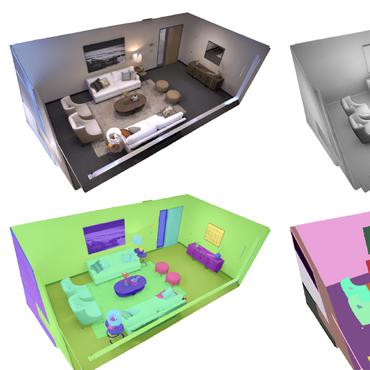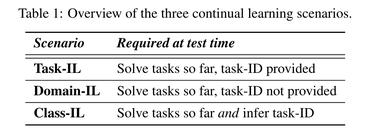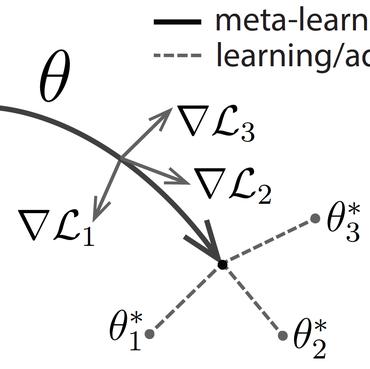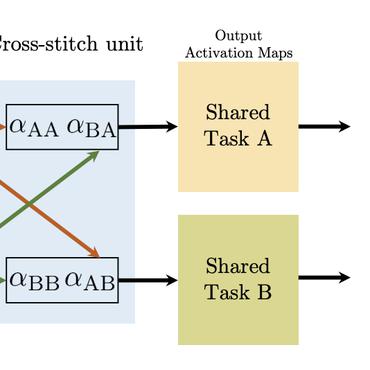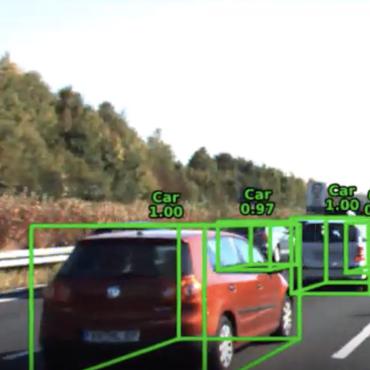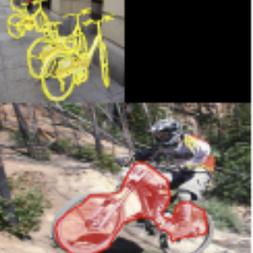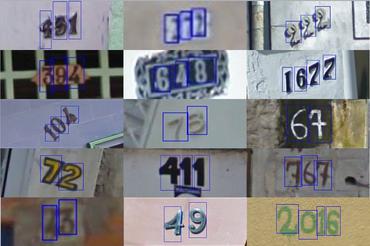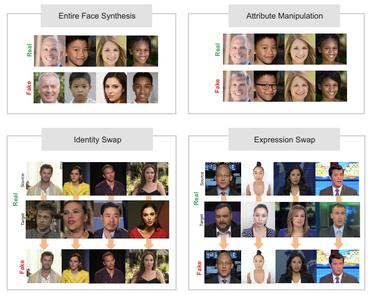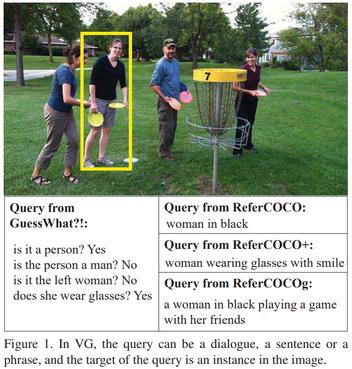Search Results for author: Yu-Gang Jiang
Found 151 papers, 75 papers with code
Hierarchical Visual-Textual Graph for Temporal Activity Localization via Language
1 code implementation • ECCV 2020 • Shaoxiang Chen, Yu-Gang Jiang
Temporal Activity Localization via Language (TALL) in video is a recently proposed challenging vision task, and tackling it requires fine-grained understanding of the video content, however, this is overlooked by most of the existing works.
MotionFollower: Editing Video Motion via Lightweight Score-Guided Diffusion
no code implementations • 30 May 2024 • Shuyuan Tu, Qi Dai, Zihao Zhang, Sicheng Xie, Zhi-Qi Cheng, Chong Luo, Xintong Han, Zuxuan Wu, Yu-Gang Jiang
In this paper, we propose MotionFollower, a lightweight score-guided diffusion model for video motion editing.
White-box Multimodal Jailbreaks Against Large Vision-Language Models
no code implementations • 28 May 2024 • Ruofan Wang, Xingjun Ma, Hanxu Zhou, Chuanjun Ji, Guangnan Ye, Yu-Gang Jiang
Subsequently, an adversarial text suffix is integrated and co-optimized with the adversarial image prefix to maximize the probability of eliciting affirmative responses to various harmful instructions.
ModelLock: Locking Your Model With a Spell
no code implementations • 25 May 2024 • Yifeng Gao, Yuhua Sun, Xingjun Ma, Zuxuan Wu, Yu-Gang Jiang
This paper presents a novel model protection paradigm ModelLock that locks (destroys) the performance of a model on normal clean data so as to make it unusable or unextractable without the right key.
Automating the Diagnosis of Human Vision Disorders by Cross-modal 3D Generation
1 code implementation • 24 May 2024 • Li Zhang, Yuankun Yang, Ziyang Xie, Zhiyuan Yuan, Jianfeng Feng, Xiatian Zhu, Yu-Gang Jiang
Understanding the hidden mechanisms behind human's visual perception is a fundamental quest in neuroscience, underpins a wide variety of critical applications, e. g. clinical diagnosis.
Adaptive Rentention & Correction for Continual Learning
no code implementations • 23 May 2024 • Haoran Chen, Micah Goldblum, Zuxuan Wu, Yu-Gang Jiang
A common problem in continual learning is the classification layer's bias towards the most recent task.
FedCAda: Adaptive Client-Side Optimization for Accelerated and Stable Federated Learning
no code implementations • 20 May 2024 • Liuzhi Zhou, Yu He, Kun Zhai, Xiang Liu, Sen Liu, Xingjun Ma, Guangnan Ye, Yu-Gang Jiang, Hongfeng Chai
This comparative analysis revealed that due to the limited information contained within client models from other clients during the initial stages of federated learning, more substantial constraints need to be imposed on the parameters of the adaptive algorithm.
Zero-shot High-fidelity and Pose-controllable Character Animation
no code implementations • 21 Apr 2024 • Bingwen Zhu, Fanyi Wang, Tianyi Lu, Peng Liu, Jingwen Su, Jinxiu Liu, Yanhao Zhang, Zuxuan Wu, Guo-Jun Qi, Yu-Gang Jiang
Image-to-video (I2V) generation aims to create a video sequence from a single image, which requires high temporal coherence and visual fidelity.
Eyes Can Deceive: Benchmarking Counterfactual Reasoning Abilities of Multi-modal Large Language Models
no code implementations • 19 Apr 2024 • Yian Li, Wentao Tian, Yang Jiao, Jingjing Chen, Yu-Gang Jiang
Counterfactual reasoning, as a crucial manifestation of human intelligence, refers to making presuppositions based on established facts and extrapolating potential outcomes.
The Dog Walking Theory: Rethinking Convergence in Federated Learning
no code implementations • 18 Apr 2024 • Kun Zhai, Yifeng Gao, Xingjun Ma, Difan Zou, Guangnan Ye, Yu-Gang Jiang
In this paper, we study the convergence of FL on non-IID data and propose a novel \emph{Dog Walking Theory} to formulate and identify the missing element in existing research.
Learning to Rank Patches for Unbiased Image Redundancy Reduction
1 code implementation • 31 Mar 2024 • Yang Luo, Zhineng Chen, Peng Zhou, Zuxuan Wu, Xieping Gao, Yu-Gang Jiang
The results demonstrate that LTRP outperforms both supervised and other self-supervised methods due to the fair assessment of image content.
OmniVid: A Generative Framework for Universal Video Understanding
1 code implementation • 26 Mar 2024 • Junke Wang, Dongdong Chen, Chong Luo, Bo He, Lu Yuan, Zuxuan Wu, Yu-Gang Jiang
The core of video understanding tasks, such as recognition, captioning, and tracking, is to automatically detect objects or actions in a video and analyze their temporal evolution.
Whose Side Are You On? Investigating the Political Stance of Large Language Models
1 code implementation • 15 Mar 2024 • Pagnarasmey Pit, Xingjun Ma, Mike Conway, Qingyu Chen, James Bailey, Henry Pit, Putrasmey Keo, Watey Diep, Yu-Gang Jiang
Large Language Models (LLMs) have gained significant popularity for their application in various everyday tasks such as text generation, summarization, and information retrieval.
FDGaussian: Fast Gaussian Splatting from Single Image via Geometric-aware Diffusion Model
no code implementations • 15 Mar 2024 • Qijun Feng, Zhen Xing, Zuxuan Wu, Yu-Gang Jiang
Reconstructing detailed 3D objects from single-view images remains a challenging task due to the limited information available.
From Canteen Food to Daily Meals: Generalizing Food Recognition to More Practical Scenarios
no code implementations • 12 Mar 2024 • Guoshan Liu, Yang Jiao, Jingjing Chen, Bin Zhu, Yu-Gang Jiang
These two datasets are used to evaluate the transferability of approaches from the well-curated food image domain to the everyday-life food image domain.
Lumen: Unleashing Versatile Vision-Centric Capabilities of Large Multimodal Models
1 code implementation • 12 Mar 2024 • Yang Jiao, Shaoxiang Chen, Zequn Jie, Jingjing Chen, Lin Ma, Yu-Gang Jiang
To address this issue, we propose a novel LMM architecture named Lumen, a Large multimodal model with versatile vision-centric capability enhancement.
Doubly Abductive Counterfactual Inference for Text-based Image Editing
1 code implementation • 5 Mar 2024 • Xue Song, Jiequan Cui, Hanwang Zhang, Jingjing Chen, Richang Hong, Yu-Gang Jiang
Through the lens of the formulation, we find that the crux of TBIE is that existing techniques hardly achieve a good trade-off between editability and fidelity, mainly due to the overfitting of the single-image fine-tuning.
Instruction-Guided Scene Text Recognition
no code implementations • 31 Jan 2024 • Yongkun Du, Zhineng Chen, Yuchen Su, Caiyan Jia, Yu-Gang Jiang
Multi-modal models have shown appealing performance in visual tasks recently, as instruction-guided training has evoked the ability to understand fine-grained visual content.
MouSi: Poly-Visual-Expert Vision-Language Models
1 code implementation • 30 Jan 2024 • Xiaoran Fan, Tao Ji, Changhao Jiang, Shuo Li, Senjie Jin, Sirui Song, Junke Wang, Boyang Hong, Lu Chen, Guodong Zheng, Ming Zhang, Caishuang Huang, Rui Zheng, Zhiheng Xi, Yuhao Zhou, Shihan Dou, Junjie Ye, Hang Yan, Tao Gui, Qi Zhang, Xipeng Qiu, Xuanjing Huang, Zuxuan Wu, Yu-Gang Jiang
This technique introduces a fusion network to unify the processing of outputs from different visual experts, while bridging the gap between image encoders and pre-trained LLMs.
 Ranked #53 on
Visual Question Answering
on MM-Vet
Ranked #53 on
Visual Question Answering
on MM-Vet
Multi-Trigger Backdoor Attacks: More Triggers, More Threats
no code implementations • 27 Jan 2024 • Yige Li, Xingjun Ma, Jiabo He, Hanxun Huang, Yu-Gang Jiang
Arguably, real-world backdoor attacks can be much more complex, e. g., the existence of multiple adversaries for the same dataset if it is of high value.
Secrets of RLHF in Large Language Models Part II: Reward Modeling
1 code implementation • 11 Jan 2024 • Binghai Wang, Rui Zheng, Lu Chen, Yan Liu, Shihan Dou, Caishuang Huang, Wei Shen, Senjie Jin, Enyu Zhou, Chenyu Shi, Songyang Gao, Nuo Xu, Yuhao Zhou, Xiaoran Fan, Zhiheng Xi, Jun Zhao, Xiao Wang, Tao Ji, Hang Yan, Lixing Shen, Zhan Chen, Tao Gui, Qi Zhang, Xipeng Qiu, Xuanjing Huang, Zuxuan Wu, Yu-Gang Jiang
We introduce a series of novel methods to mitigate the influence of incorrect and ambiguous preferences in the dataset and fully leverage high-quality preference data.
FoodLMM: A Versatile Food Assistant using Large Multi-modal Model
no code implementations • 22 Dec 2023 • Yuehao Yin, Huiyan Qi, Bin Zhu, Jingjing Chen, Yu-Gang Jiang, Chong-Wah Ngo
In the second stage, we construct a multi-round conversation dataset and a reasoning segmentation dataset to fine-tune the model, enabling it to conduct professional dialogues and generate segmentation masks based on complex reasoning in the food domain.
Instance-aware Multi-Camera 3D Object Detection with Structural Priors Mining and Self-Boosting Learning
no code implementations • 13 Dec 2023 • Yang Jiao, Zequn Jie, Shaoxiang Chen, Lechao Cheng, Jingjing Chen, Lin Ma, Yu-Gang Jiang
Camera-based bird-eye-view (BEV) perception paradigm has made significant progress in the autonomous driving field.
MotionEditor: Editing Video Motion via Content-Aware Diffusion
1 code implementation • 30 Nov 2023 • Shuyuan Tu, Qi Dai, Zhi-Qi Cheng, Han Hu, Xintong Han, Zuxuan Wu, Yu-Gang Jiang
This mechanism enables the editing branch to query the key and value from the reconstruction branch in a decoupled manner, making the editing branch retain the original background and protagonist appearance.
VIDiff: Translating Videos via Multi-Modal Instructions with Diffusion Models
no code implementations • 30 Nov 2023 • Zhen Xing, Qi Dai, Zihao Zhang, HUI ZHANG, Han Hu, Zuxuan Wu, Yu-Gang Jiang
Our model can edit and translate the desired results within seconds based on user instructions.
VideoAssembler: Identity-Consistent Video Generation with Reference Entities using Diffusion Model
1 code implementation • 29 Nov 2023 • Haoyu Zhao, Tianyi Lu, Jiaxi Gu, Xing Zhang, Zuxuan Wu, Hang Xu, Yu-Gang Jiang
Identity-consistent video generation seeks to synthesize videos that are guided by both textual prompts and reference images of entities.
 Ranked #1 on
Video Generation
on MSR-VTT
Ranked #1 on
Video Generation
on MSR-VTT
AdaDiff: Adaptive Step Selection for Fast Diffusion
no code implementations • 24 Nov 2023 • HUI ZHANG, Zuxuan Wu, Zhen Xing, Jie Shao, Yu-Gang Jiang
Diffusion models, as a type of generative models, have achieved impressive results in generating images and videos conditioned on textual conditions.
SEGIC: Unleashing the Emergent Correspondence for In-Context Segmentation
1 code implementation • 24 Nov 2023 • Lingchen Meng, Shiyi Lan, Hengduo Li, Jose M. Alvarez, Zuxuan Wu, Yu-Gang Jiang
In-context segmentation aims at segmenting novel images using a few labeled example images, termed as "in-context examples", exploring content similarities between examples and the target.
Adversarial Prompt Tuning for Vision-Language Models
1 code implementation • 19 Nov 2023 • Jiaming Zhang, Xingjun Ma, Xin Wang, Lingyu Qiu, Jiaqi Wang, Yu-Gang Jiang, Jitao Sang
With the rapid advancement of multimodal learning, pre-trained Vision-Language Models (VLMs) such as CLIP have demonstrated remarkable capacities in bridging the gap between visual and language modalities.
To See is to Believe: Prompting GPT-4V for Better Visual Instruction Tuning
2 code implementations • 13 Nov 2023 • Junke Wang, Lingchen Meng, Zejia Weng, Bo He, Zuxuan Wu, Yu-Gang Jiang
Existing visual instruction tuning methods typically prompt large language models with textual descriptions to generate instruction-following data.
 Ranked #46 on
Visual Question Answering
on MM-Vet
Ranked #46 on
Visual Question Answering
on MM-Vet
Fake Alignment: Are LLMs Really Aligned Well?
1 code implementation • 10 Nov 2023 • Yixu Wang, Yan Teng, Kexin Huang, Chengqi Lyu, Songyang Zhang, Wenwei Zhang, Xingjun Ma, Yu-Gang Jiang, Yu Qiao, Yingchun Wang
The growing awareness of safety concerns in large language models (LLMs) has sparked considerable interest in the evaluation of safety.
A Survey on Video Diffusion Models
1 code implementation • 16 Oct 2023 • Zhen Xing, Qijun Feng, Haoran Chen, Qi Dai, Han Hu, Hang Xu, Zuxuan Wu, Yu-Gang Jiang
However, existing surveys mainly focus on diffusion models in the context of image generation, with few up-to-date reviews on their application in the video domain.
Building an Open-Vocabulary Video CLIP Model with Better Architectures, Optimization and Data
1 code implementation • 8 Oct 2023 • Zuxuan Wu, Zejia Weng, Wujian Peng, Xitong Yang, Ang Li, Larry S. Davis, Yu-Gang Jiang
Despite significant results achieved by Contrastive Language-Image Pretraining (CLIP) in zero-shot image recognition, limited effort has been made exploring its potential for zero-shot video recognition.
Reuse and Diffuse: Iterative Denoising for Text-to-Video Generation
no code implementations • 7 Sep 2023 • Jiaxi Gu, Shicong Wang, Haoyu Zhao, Tianyi Lu, Xing Zhang, Zuxuan Wu, Songcen Xu, Wei zhang, Yu-Gang Jiang, Hang Xu
Conditioned on an initial video clip with a small number of frames, additional frames are iteratively generated by reusing the original latent features and following the previous diffusion process.
SimDA: Simple Diffusion Adapter for Efficient Video Generation
no code implementations • 18 Aug 2023 • Zhen Xing, Qi Dai, Han Hu, Zuxuan Wu, Yu-Gang Jiang
In this work, we propose a Simple Diffusion Adapter (SimDA) that fine-tunes only 24M out of 1. 1B parameters of a strong T2I model, adapting it to video generation in a parameter-efficient way.
On the Importance of Spatial Relations for Few-shot Action Recognition
no code implementations • 14 Aug 2023 • Yilun Zhang, Yuqian Fu, Xingjun Ma, Lizhe Qi, Jingjing Chen, Zuxuan Wu, Yu-Gang Jiang
We are thus motivated to investigate the importance of spatial relations and propose a more accurate few-shot action recognition method that leverages both spatial and temporal information.
Context Perception Parallel Decoder for Scene Text Recognition
1 code implementation • 23 Jul 2023 • Yongkun Du, Zhineng Chen, Caiyan Jia, Xiaoting Yin, Chenxia Li, Yuning Du, Yu-Gang Jiang
We first present an empirical study of AR decoding in STR, and discover that the AR decoder not only models linguistic context, but also provides guidance on visual context perception.
 Ranked #1 on
Scene Text Recognition
on CUTE80
(using extra training data)
Ranked #1 on
Scene Text Recognition
on CUTE80
(using extra training data)
LRANet: Towards Accurate and Efficient Scene Text Detection with Low-Rank Approximation Network
1 code implementation • 27 Jun 2023 • Yuchen Su, Zhineng Chen, Zhiwen Shao, Yuning Du, Zhilong Ji, Jinfeng Bai, Yong Zhou, Yu-Gang Jiang
Next, we propose a dual assignment scheme for speed acceleration.
Prompting Large Language Models to Reformulate Queries for Moment Localization
no code implementations • 6 Jun 2023 • Wenfeng Yan, Shaoxiang Chen, Zuxuan Wu, Yu-Gang Jiang
The task of moment localization is to localize a temporal moment in an untrimmed video for a given natural language query.
Reconstructive Neuron Pruning for Backdoor Defense
1 code implementation • 24 May 2023 • Yige Li, Xixiang Lyu, Xingjun Ma, Nodens Koren, Lingjuan Lyu, Bo Li, Yu-Gang Jiang
Specifically, RNP first unlearns the neurons by maximizing the model's error on a small subset of clean samples and then recovers the neurons by minimizing the model's error on the same data.
MRN: Multiplexed Routing Network for Incremental Multilingual Text Recognition
1 code implementation • ICCV 2023 • Tianlun Zheng, Zhineng Chen, Bingchen Huang, Wei zhang, Yu-Gang Jiang
In this paper, we propose the Incremental MLTR (IMLTR) task in the context of incremental learning (IL), where different languages are introduced in batches.
 Ranked #1 on
Incremental Learning
on MLT17
Ranked #1 on
Incremental Learning
on MLT17
NuScenes-QA: A Multi-modal Visual Question Answering Benchmark for Autonomous Driving Scenario
2 code implementations • 24 May 2023 • Tianwen Qian, Jingjing Chen, Linhai Zhuo, Yang Jiao, Yu-Gang Jiang
We introduce a novel visual question answering (VQA) task in the context of autonomous driving, aiming to answer natural language questions based on street-view clues.
TPS++: Attention-Enhanced Thin-Plate Spline for Scene Text Recognition
1 code implementation • 9 May 2023 • Tianlun Zheng, Zhineng Chen, Jinfeng Bai, Hongtao Xie, Yu-Gang Jiang
In this work, we introduce TPS++, an attention-enhanced TPS transformation that incorporates the attention mechanism to text rectification for the first time.
 Ranked #1 on
Scene Text Recognition
on SVT-P
Ranked #1 on
Scene Text Recognition
on SVT-P
ChatVideo: A Tracklet-centric Multimodal and Versatile Video Understanding System
no code implementations • 27 Apr 2023 • Junke Wang, Dongdong Chen, Chong Luo, Xiyang Dai, Lu Yuan, Zuxuan Wu, Yu-Gang Jiang
Existing deep video models are limited by specific tasks, fixed input-output spaces, and poor generalization capabilities, making it difficult to deploy them in real-world scenarios.
Implicit Temporal Modeling with Learnable Alignment for Video Recognition
1 code implementation • ICCV 2023 • Shuyuan Tu, Qi Dai, Zuxuan Wu, Zhi-Qi Cheng, Han Hu, Yu-Gang Jiang
While modeling temporal information within straight through tube is widely adopted in literature, we find that simple frame alignment already provides enough essence without temporal attention.
 Ranked #16 on
Action Classification
on Kinetics-400
Ranked #16 on
Action Classification
on Kinetics-400
OmniTracker: Unifying Object Tracking by Tracking-with-Detection
no code implementations • 21 Mar 2023 • Junke Wang, Dongdong Chen, Zuxuan Wu, Chong Luo, Xiyang Dai, Lu Yuan, Yu-Gang Jiang
Object tracking (OT) aims to estimate the positions of target objects in a video sequence.
DiffusionAD: Norm-guided One-step Denoising Diffusion for Anomaly Detection
1 code implementation • 15 Mar 2023 • HUI ZHANG, Zheng Wang, Zuxuan Wu, Yu-Gang Jiang
Anomaly detection has garnered extensive applications in real industrial manufacturing due to its remarkable effectiveness and efficiency.
 Ranked #1 on
Anomaly Detection
on VisA
Ranked #1 on
Anomaly Detection
on VisA
PromptFusion: Decoupling Stability and Plasticity for Continual Learning
no code implementations • 13 Mar 2023 • Haoran Chen, Zuxuan Wu, Xintong Han, Menglin Jia, Yu-Gang Jiang
Such a trade-off is referred to as the stabilityplasticity dilemma and is a more general and challenging problem for continual learning.
StyleAdv: Meta Style Adversarial Training for Cross-Domain Few-Shot Learning
2 code implementations • CVPR 2023 • Yuqian Fu, Yu Xie, Yanwei Fu, Yu-Gang Jiang
Thus, inspired by vanilla adversarial learning, a novel model-agnostic meta Style Adversarial training (StyleAdv) method together with a novel style adversarial attack method is proposed for CD-FSL.
 Ranked #1 on
Cross-Domain Few-Shot
on Plantae
Ranked #1 on
Cross-Domain Few-Shot
on Plantae
Open-VCLIP: Transforming CLIP to an Open-vocabulary Video Model via Interpolated Weight Optimization
1 code implementation • 1 Feb 2023 • Zejia Weng, Xitong Yang, Ang Li, Zuxuan Wu, Yu-Gang Jiang
Our framework extends CLIP with minimal modifications to model spatial-temporal relationships in videos, making it a specialized video classifier, while striving for generalization.
Vocabulary-informed Zero-shot and Open-set Learning
1 code implementation • 3 Jan 2023 • Yanwei Fu, Xiaomei Wang, Hanze Dong, Yu-Gang Jiang, Meng Wang, xiangyang xue, Leonid Sigal
Despite significant progress in object categorization, in recent years, a number of important challenges remain; mainly, the ability to learn from limited labeled data and to recognize object classes within large, potentially open, set of labels.
Bi-Directional Feature Fusion Generative Adversarial Network for Ultra-High Resolution Pathological Image Virtual Re-Staining
no code implementations • CVPR 2023 • Kexin Sun, Zhineng Chen, Gongwei Wang, Jun Liu, Xiongjun Ye, Yu-Gang Jiang
In order to eliminate the square effect, we design a bi-directional feature fusion generative adversarial network (BFF-GAN) with a global branch and a local branch.
Unlearnable Clusters: Towards Label-agnostic Unlearnable Examples
1 code implementation • CVPR 2023 • Jiaming Zhang, Xingjun Ma, Qi Yi, Jitao Sang, Yu-Gang Jiang, YaoWei Wang, Changsheng Xu
Furthermore, we propose to leverage VisionandLanguage Pre-trained Models (VLPMs) like CLIP as the surrogate model to improve the transferability of the crafted UCs to diverse domains.
Look Before You Match: Instance Understanding Matters in Video Object Segmentation
no code implementations • CVPR 2023 • Junke Wang, Dongdong Chen, Zuxuan Wu, Chong Luo, Chuanxin Tang, Xiyang Dai, Yucheng Zhao, Yujia Xie, Lu Yuan, Yu-Gang Jiang
Towards this goal, we present a two-branch network for VOS, where the query-based instance segmentation (IS) branch delves into the instance details of the current frame and the VOS branch performs spatial-temporal matching with the memory bank.
 Ranked #1 on
Semi-Supervised Video Object Segmentation
on Long Video Dataset
(using extra training data)
Ranked #1 on
Semi-Supervised Video Object Segmentation
on Long Video Dataset
(using extra training data)
Fighting Malicious Media Data: A Survey on Tampering Detection and Deepfake Detection
no code implementations • 12 Dec 2022 • Junke Wang, Zhenxin Li, Chao Zhang, Jingjing Chen, Zuxuan Wu, Larry S. Davis, Yu-Gang Jiang
Online media data, in the forms of images and videos, are becoming mainstream communication channels.
Masked Video Distillation: Rethinking Masked Feature Modeling for Self-supervised Video Representation Learning
4 code implementations • CVPR 2023 • Rui Wang, Dongdong Chen, Zuxuan Wu, Yinpeng Chen, Xiyang Dai, Mengchen Liu, Lu Yuan, Yu-Gang Jiang
For the choice of teacher models, we observe that students taught by video teachers perform better on temporally-heavy video tasks, while image teachers transfer stronger spatial representations for spatially-heavy video tasks.
 Ranked #1 on
Self-Supervised Action Recognition
on HMDB51
Ranked #1 on
Self-Supervised Action Recognition
on HMDB51
Prototypical Residual Networks for Anomaly Detection and Localization
no code implementations • CVPR 2023 • HUI ZHANG, Zuxuan Wu, Zheng Wang, Zhineng Chen, Yu-Gang Jiang
Anomaly detection and localization are widely used in industrial manufacturing for its efficiency and effectiveness.
 Ranked #2 on
Supervised Anomaly Detection
on MVTec AD
(using extra training data)
Ranked #2 on
Supervised Anomaly Detection
on MVTec AD
(using extra training data)
ResFormer: Scaling ViTs with Multi-Resolution Training
1 code implementation • CVPR 2023 • Rui Tian, Zuxuan Wu, Qi Dai, Han Hu, Yu Qiao, Yu-Gang Jiang
We introduce, ResFormer, a framework that is built upon the seminal idea of multi-resolution training for improved performance on a wide spectrum of, mostly unseen, testing resolutions.
Transferability Estimation Based On Principal Gradient Expectation
no code implementations • 29 Nov 2022 • Huiyan Qi, Lechao Cheng, Jingjing Chen, Yue Yu, Xue Song, Zunlei Feng, Yu-Gang Jiang
Transfer learning aims to improve the performance of target tasks by transferring knowledge acquired in source tasks.
SVFormer: Semi-supervised Video Transformer for Action Recognition
1 code implementation • CVPR 2023 • Zhen Xing, Qi Dai, Han Hu, Jingjing Chen, Zuxuan Wu, Yu-Gang Jiang
In this paper, we investigate the use of transformer models under the SSL setting for action recognition.
TGDM: Target Guided Dynamic Mixup for Cross-Domain Few-Shot Learning
1 code implementation • 11 Oct 2022 • Linhai Zhuo, Yuqian Fu, Jingjing Chen, Yixin Cao, Yu-Gang Jiang
The proposed TGDM framework contains a Mixup-3T network for learning classifiers and a dynamic ratio generation network (DRGN) for learning the optimal mix ratio.
ME-D2N: Multi-Expert Domain Decompositional Network for Cross-Domain Few-Shot Learning
1 code implementation • 11 Oct 2022 • Yuqian Fu, Yu Xie, Yanwei Fu, Jingjing Chen, Yu-Gang Jiang
Concretely, to solve the data imbalance problem between the source data with sufficient examples and the auxiliary target data with limited examples, we build our model under the umbrella of multi-expert learning.
Text-driven Video Prediction
no code implementations • 6 Oct 2022 • Xue Song, Jingjing Chen, Bin Zhu, Yu-Gang Jiang
Specifically, appearance and motion components are provided by the image and caption separately.
Locate before Answering: Answer Guided Question Localization for Video Question Answering
no code implementations • 5 Oct 2022 • Tianwen Qian, Ran Cui, Jingjing Chen, Pai Peng, Xiaowei Guo, Yu-Gang Jiang
Considering the fact that the question often remains concentrated in a short temporal range, we propose to first locate the question to a segment in the video and then infer the answer using the located segment only.
Semi-Supervised Single-View 3D Reconstruction via Prototype Shape Priors
1 code implementation • 30 Sep 2022 • Zhen Xing, Hengduo Li, Zuxuan Wu, Yu-Gang Jiang
In particular, we introduce an attention-guided prototype shape prior module for guiding realistic object reconstruction.
Multi-Prompt Alignment for Multi-Source Unsupervised Domain Adaptation
1 code implementation • NeurIPS 2023 • Haoran Chen, Xintong Han, Zuxuan Wu, Yu-Gang Jiang
Most existing methods for unsupervised domain adaptation (UDA) rely on a shared network to extract domain-invariant features.
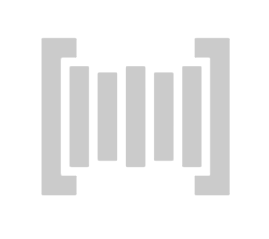 Multi-Source Unsupervised Domain Adaptation
Multi-Source Unsupervised Domain Adaptation
 Unsupervised Domain Adaptation
Unsupervised Domain Adaptation
OmniVL:One Foundation Model for Image-Language and Video-Language Tasks
no code implementations • 15 Sep 2022 • Junke Wang, Dongdong Chen, Zuxuan Wu, Chong Luo, Luowei Zhou, Yucheng Zhao, Yujia Xie, Ce Liu, Yu-Gang Jiang, Lu Yuan
This paper presents OmniVL, a new foundation model to support both image-language and video-language tasks using one universal architecture.
 Ranked #4 on
Cross-Modal Retrieval
on Flickr30k
(using extra training data)
Ranked #4 on
Cross-Modal Retrieval
on Flickr30k
(using extra training data)
Enhancing the Self-Universality for Transferable Targeted Attacks
1 code implementation • CVPR 2023 • Zhipeng Wei, Jingjing Chen, Zuxuan Wu, Yu-Gang Jiang
Our new attack method is proposed based on the observation that highly universal adversarial perturbations tend to be more transferable for targeted attacks.
MSMDFusion: Fusing LiDAR and Camera at Multiple Scales with Multi-Depth Seeds for 3D Object Detection
1 code implementation • CVPR 2023 • Yang Jiao, Zequn Jie, Shaoxiang Chen, Jingjing Chen, Lin Ma, Yu-Gang Jiang
Recent approaches aim at exploring the semantic densities of camera features through lifting points in 2D camera images (referred to as seeds) into 3D space, and then incorporate 2D semantics via cross-modal interaction or fusion techniques.
Video Mobile-Former: Video Recognition with Efficient Global Spatial-temporal Modeling
no code implementations • 25 Aug 2022 • Rui Wang, Zuxuan Wu, Dongdong Chen, Yinpeng Chen, Xiyang Dai, Mengchen Liu, Luowei Zhou, Lu Yuan, Yu-Gang Jiang
To avoid significant computational cost incurred by computing self-attention between the large number of local patches in videos, we propose to use very few global tokens (e. g., 6) for a whole video in Transformers to exchange information with 3D-CNNs with a cross-attention mechanism.
Balanced Contrastive Learning for Long-Tailed Visual Recognition
1 code implementation • CVPR 2022 • Jianggang Zhu, Zheng Wang, Jingjing Chen, Yi-Ping Phoebe Chen, Yu-Gang Jiang
In this paper, we focus on representation learning for imbalanced data.
PolarFormer: Multi-camera 3D Object Detection with Polar Transformer
1 code implementation • 30 Jun 2022 • Yanqin Jiang, Li Zhang, Zhenwei Miao, Xiatian Zhu, Jin Gao, Weiming Hu, Yu-Gang Jiang
3D object detection in autonomous driving aims to reason "what" and "where" the objects of interest present in a 3D world.
 Ranked #2 on
Robust Camera Only 3D Object Detection
on nuScenes-C
Ranked #2 on
Robust Camera Only 3D Object Detection
on nuScenes-C
Detection Hub: Unifying Object Detection Datasets via Query Adaptation on Language Embedding
no code implementations • CVPR 2023 • Lingchen Meng, Xiyang Dai, Yinpeng Chen, Pengchuan Zhang, Dongdong Chen, Mengchen Liu, JianFeng Wang, Zuxuan Wu, Lu Yuan, Yu-Gang Jiang
Detection Hub further achieves SoTA performance on UODB benchmark with wide variety of datasets.
SVTR: Scene Text Recognition with a Single Visual Model
2 code implementations • 30 Apr 2022 • Yongkun Du, Zhineng Chen, Caiyan Jia, Xiaoting Yin, Tianlun Zheng, Chenxia Li, Yuning Du, Yu-Gang Jiang
Dominant scene text recognition models commonly contain two building blocks, a visual model for feature extraction and a sequence model for text transcription.
 Ranked #16 on
Scene Text Recognition
on ICDAR2013
Ranked #16 on
Scene Text Recognition
on ICDAR2013
Adaptive Split-Fusion Transformer
1 code implementation • 26 Apr 2022 • Zixuan Su, Hao Zhang, Jingjing Chen, Lei Pang, Chong-Wah Ngo, Yu-Gang Jiang
Neural networks for visual content understanding have recently evolved from convolutional ones (CNNs) to transformers.
Deeper Insights into the Robustness of ViTs towards Common Corruptions
no code implementations • 26 Apr 2022 • Rui Tian, Zuxuan Wu, Qi Dai, Han Hu, Yu-Gang Jiang
With Vision Transformers (ViTs) making great advances in a variety of computer vision tasks, recent literature have proposed various variants of vanilla ViTs to achieve better efficiency and efficacy.
Video Moment Retrieval from Text Queries via Single Frame Annotation
1 code implementation • 20 Apr 2022 • Ran Cui, Tianwen Qian, Pai Peng, Elena Daskalaki, Jingjing Chen, Xiaowei Guo, Huyang Sun, Yu-Gang Jiang
Weakly supervised methods only rely on the paired video and query, but the performance is relatively poor.
ObjectFormer for Image Manipulation Detection and Localization
no code implementations • CVPR 2022 • Junke Wang, Zuxuan Wu, Jingjing Chen, Xintong Han, Abhinav Shrivastava, Ser-Nam Lim, Yu-Gang Jiang
Recent advances in image editing techniques have posed serious challenges to the trustworthiness of multimedia data, which drives the research of image tampering detection.
Wave-SAN: Wavelet based Style Augmentation Network for Cross-Domain Few-Shot Learning
1 code implementation • 15 Mar 2022 • Yuqian Fu, Yu Xie, Yanwei Fu, Jingjing Chen, Yu-Gang Jiang
The key challenge of CD-FSL lies in the huge data shift between source and target domains, which is typically in the form of totally different visual styles.
 Ranked #2 on
Cross-Domain Few-Shot
on CUB
Ranked #2 on
Cross-Domain Few-Shot
on CUB
MORE: Multi-Order RElation Mining for Dense Captioning in 3D Scenes
1 code implementation • 10 Mar 2022 • Yang Jiao, Shaoxiang Chen, Zequn Jie, Jingjing Chen, Lin Ma, Yu-Gang Jiang
3D dense captioning is a recently-proposed novel task, where point clouds contain more geometric information than the 2D counterpart.
Suspected Object Matters: Rethinking Model's Prediction for One-stage Visual Grounding
no code implementations • 10 Mar 2022 • Yang Jiao, Zequn Jie, Jingjing Chen, Lin Ma, Yu-Gang Jiang
Recently, one-stage visual grounders attract high attention due to their comparable accuracy but significantly higher efficiency than two-stage grounders.
Cross-Modal Transferable Adversarial Attacks from Images to Videos
no code implementations • CVPR 2022 • Zhipeng Wei, Jingjing Chen, Zuxuan Wu, Yu-Gang Jiang
This paper investigates the transferability of adversarial perturbation across different modalities, i. e., leveraging adversarial perturbation generated on white-box image models to attack black-box video models.
Unified Multimodal Pre-training and Prompt-based Tuning for Vision-Language Understanding and Generation
no code implementations • 10 Dec 2021 • Tianyi Liu, Zuxuan Wu, Wenhan Xiong, Jingjing Chen, Yu-Gang Jiang
Our experiments show that there is a trade-off between understanding tasks and generation tasks while using the same model, and a feasible way to improve both tasks is to use more data.
BEVT: BERT Pretraining of Video Transformers
1 code implementation • CVPR 2022 • Rui Wang, Dongdong Chen, Zuxuan Wu, Yinpeng Chen, Xiyang Dai, Mengchen Liu, Yu-Gang Jiang, Luowei Zhou, Lu Yuan
This design is motivated by two observations: 1) transformers learned on image datasets provide decent spatial priors that can ease the learning of video transformers, which are often times computationally-intensive if trained from scratch; 2) discriminative clues, i. e., spatial and temporal information, needed to make correct predictions vary among different videos due to large intra-class and inter-class variations.
 Ranked #8 on
Action Recognition
on Diving-48
Ranked #8 on
Action Recognition
on Diving-48
AdaViT: Adaptive Vision Transformers for Efficient Image Recognition
no code implementations • CVPR 2022 • Lingchen Meng, Hengduo Li, Bor-Chun Chen, Shiyi Lan, Zuxuan Wu, Yu-Gang Jiang, Ser-Nam Lim
To this end, we introduce AdaViT, an adaptive computation framework that learns to derive usage policies on which patches, self-attention heads and transformer blocks to use throughout the backbone on a per-input basis, aiming to improve inference efficiency of vision transformers with a minimal drop of accuracy for image recognition.
Efficient Video Transformers with Spatial-Temporal Token Selection
1 code implementation • 23 Nov 2021 • Junke Wang, Xitong Yang, Hengduo Li, Li Liu, Zuxuan Wu, Yu-Gang Jiang
Video transformers have achieved impressive results on major video recognition benchmarks, which however suffer from high computational cost.
CDistNet: Perceiving Multi-Domain Character Distance for Robust Text Recognition
2 code implementations • 22 Nov 2021 • Tianlun Zheng, Zhineng Chen, Shancheng Fang, Hongtao Xie, Yu-Gang Jiang
In this paper, we propose a novel module called Multi-Domain Character Distance Perception (MDCDP) to establish a visually and semantically related position embedding.
 Ranked #12 on
Scene Text Recognition
on ICDAR2015
Ranked #12 on
Scene Text Recognition
on ICDAR2015
Semi-Supervised Vision Transformers
1 code implementation • 22 Nov 2021 • Zejia Weng, Xitong Yang, Ang Li, Zuxuan Wu, Yu-Gang Jiang
Surprisingly, we show Vision Transformers perform significantly worse than Convolutional Neural Networks when only a small set of labeled data is available.
Attacking Video Recognition Models with Bullet-Screen Comments
1 code implementation • 29 Oct 2021 • Kai Chen, Zhipeng Wei, Jingjing Chen, Zuxuan Wu, Yu-Gang Jiang
On both UCF-101 and HMDB-51 datasets, our BSC attack method can achieve about 90\% fooling rate when attacking three mainstream video recognition models, while only occluding \textless 8\% areas in the video.
 Adversarial Attack
Adversarial Attack
 Adversarial Attack on Video Classification
+2
Adversarial Attack on Video Classification
+2
Boosting the Transferability of Video Adversarial Examples via Temporal Translation
1 code implementation • 18 Oct 2021 • Zhipeng Wei, Jingjing Chen, Zuxuan Wu, Yu-Gang Jiang
To this end, we propose to boost the transferability of video adversarial examples for black-box attacks on video recognition models.
Two-stage Visual Cues Enhancement Network for Referring Image Segmentation
1 code implementation • 9 Oct 2021 • Yang Jiao, Zequn Jie, Weixin Luo, Jingjing Chen, Yu-Gang Jiang, Xiaolin Wei, Lin Ma
Referring Image Segmentation (RIS) aims at segmenting the target object from an image referred by one given natural language expression.
Self-supervised Learning for Semi-supervised Temporal Language Grounding
no code implementations • 23 Sep 2021 • Fan Luo, Shaoxiang Chen, Jingjing Chen, Zuxuan Wu, Yu-Gang Jiang
Given a text description, Temporal Language Grounding (TLG) aims to localize temporal boundaries of the segments that contain the specified semantics in an untrimmed video.
Towards Transferable Adversarial Attacks on Vision Transformers
2 code implementations • 9 Sep 2021 • Zhipeng Wei, Jingjing Chen, Micah Goldblum, Zuxuan Wu, Tom Goldstein, Yu-Gang Jiang
We evaluate the transferability of attacks on state-of-the-art ViTs, CNNs and robustly trained CNNs.
A Multimodal Framework for Video Ads Understanding
no code implementations • 29 Aug 2021 • Zejia Weng, Lingchen Meng, Rui Wang, Zuxuan Wu, Yu-Gang Jiang
There is a growing trend in placing video advertisements on social platforms for online marketing, which demands automatic approaches to understand the contents of advertisements effectively.
Revisiting Adversarial Robustness Distillation: Robust Soft Labels Make Student Better
1 code implementation • ICCV 2021 • Bojia Zi, Shihao Zhao, Xingjun Ma, Yu-Gang Jiang
We empirically demonstrate the effectiveness of our RSLAD approach over existing adversarial training and distillation methods in improving the robustness of small models against state-of-the-art attacks including the AutoAttack.
FT-TDR: Frequency-guided Transformer and Top-Down Refinement Network for Blind Face Inpainting
no code implementations • 10 Aug 2021 • Junke Wang, Shaoxiang Chen, Zuxuan Wu, Yu-Gang Jiang
Blind face inpainting refers to the task of reconstructing visual contents without explicitly indicating the corrupted regions in a face image.
Meta-FDMixup: Cross-Domain Few-Shot Learning Guided by Labeled Target Data
1 code implementation • 26 Jul 2021 • Yuqian Fu, Yanwei Fu, Yu-Gang Jiang
Secondly, a novel disentangle module together with a domain classifier is proposed to extract the disentangled domain-irrelevant and domain-specific features.
Can Action be Imitated? Learn to Reconstruct and Transfer Human Dynamics from Videos
no code implementations • 25 Jul 2021 • Yuqian Fu, Yanwei Fu, Yu-Gang Jiang
To achieve this, a novel Mesh-based Video Action Imitation (M-VAI) method is proposed by us.
Towards Bridging Event Captioner and Sentence Localizer for Weakly Supervised Dense Event Captioning
no code implementations • CVPR 2021 • Shaoxiang Chen, Yu-Gang Jiang
Dense Event Captioning (DEC) aims to jointly localize and describe multiple events of interest in untrimmed videos, which is an advancement of the conventional video captioning task (generating a single sentence description for a trimmed video).
Cross-domain Contrastive Learning for Unsupervised Domain Adaptation
1 code implementation • 10 Jun 2021 • Rui Wang, Zuxuan Wu, Zejia Weng, Jingjing Chen, Guo-Jun Qi, Yu-Gang Jiang
Unsupervised domain adaptation (UDA) aims to transfer knowledge learned from a fully-labeled source domain to a different unlabeled target domain.
VideoLT: Large-scale Long-tailed Video Recognition
1 code implementation • ICCV 2021 • Xing Zhang, Zuxuan Wu, Zejia Weng, Huazhu Fu, Jingjing Chen, Yu-Gang Jiang, Larry Davis
In this paper, we introduce VideoLT, a large-scale long-tailed video recognition dataset, as a step toward real-world video recognition.
M2TR: Multi-modal Multi-scale Transformers for Deepfake Detection
2 code implementations • 20 Apr 2021 • Junke Wang, Zuxuan Wu, Wenhao Ouyang, Xintong Han, Jingjing Chen, Ser-Nam Lim, Yu-Gang Jiang
The widespread dissemination of Deepfakes demands effective approaches that can detect perceptually convincing forged images.
HCMS: Hierarchical and Conditional Modality Selection for Efficient Video Recognition
no code implementations • 20 Apr 2021 • Zejia Weng, Zuxuan Wu, Hengduo Li, Jingjing Chen, Yu-Gang Jiang
Conventional video recognition pipelines typically fuse multimodal features for improved performance.
What Do Deep Nets Learn? Class-wise Patterns Revealed in the Input Space
no code implementations • 18 Jan 2021 • Shihao Zhao, Xingjun Ma, Yisen Wang, James Bailey, Bo Li, Yu-Gang Jiang
In this paper, we focus on image classification and propose a method to visualize and understand the class-wise knowledge (patterns) learned by DNNs under three different settings including natural, backdoor and adversarial.
WildDeepfake: A Challenging Real-World Dataset for Deepfake Detection
1 code implementation • 5 Jan 2021 • Bojia Zi, Minghao Chang, Jingjing Chen, Xingjun Ma, Yu-Gang Jiang
WildDeepfake is a small dataset that can be used, in addition to existing datasets, to develop and test the effectiveness of deepfake detectors against real-world deepfakes.
Motion Guided Region Message Passing for Video Captioning
no code implementations • ICCV 2021 • Shaoxiang Chen, Yu-Gang Jiang
In this paper, we aim at designing a spatial information extraction and aggregation method for video captioning without the need of external object detectors.
Colonoscopy Polyp Detection: Domain Adaptation From Medical Report Images to Real-time Videos
no code implementations • 31 Dec 2020 • Zhi-Qin Zhan, Huazhu Fu, Yan-Yao Yang, Jingjing Chen, Jie Liu, Yu-Gang Jiang
However, there are several issues between the image-based training and video-based inference, including domain differences, lack of positive samples, and temporal smoothness.
Depth Guided Adaptive Meta-Fusion Network for Few-shot Video Recognition
1 code implementation • 20 Oct 2020 • Yuqian Fu, Li Zhang, Junke Wang, Yanwei Fu, Yu-Gang Jiang
Humans can easily recognize actions with only a few examples given, while the existing video recognition models still heavily rely on the large-scale labeled data inputs.
 Ranked #1 on
Few Shot Action Recognition
on Kinetics-100
Ranked #1 on
Few Shot Action Recognition
on Kinetics-100
Imbalanced Gradients: A New Cause of Overestimated Adversarial Robustness
no code implementations • 28 Sep 2020 • Linxi Jiang, Xingjun Ma, Zejia Weng, James Bailey, Yu-Gang Jiang
Evaluating the robustness of a defense model is a challenging task in adversarial robustness research.
Multi-modal Cooking Workflow Construction for Food Recipes
no code implementations • 20 Aug 2020 • Liangming Pan, Jingjing Chen, Jianlong Wu, Shaoteng Liu, Chong-Wah Ngo, Min-Yen Kan, Yu-Gang Jiang, Tat-Seng Chua
Understanding food recipe requires anticipating the implicit causal effects of cooking actions, such that the recipe can be converted into a graph describing the temporal workflow of the recipe.
Learning Modality Interaction for Temporal Sentence Localization and Event Captioning in Videos
no code implementations • ECCV 2020 • Shaoxiang Chen, Wenhao Jiang, Wei Liu, Yu-Gang Jiang
Inspired by the fact that there exist cross-modal interactions in the human brain, we propose a novel method for learning pairwise modality interactions in order to better exploit complementary information for each pair of modalities in videos and thus improve performances on both tasks.
Imbalanced Gradients: A Subtle Cause of Overestimated Adversarial Robustness
1 code implementation • 24 Jun 2020 • Xingjun Ma, Linxi Jiang, Hanxun Huang, Zejia Weng, James Bailey, Yu-Gang Jiang
Evaluating the robustness of a defense model is a challenging task in adversarial robustness research.
Long-Term Cloth-Changing Person Re-identification
no code implementations • 26 May 2020 • Xuelin Qian, Wenxuan Wang, Li Zhang, Fangrui Zhu, Yanwei Fu, Tao Xiang, Yu-Gang Jiang, xiangyang xue
Specifically, we consider that under cloth-changes, soft-biometrics such as body shape would be more reliable.
Sketch-BERT: Learning Sketch Bidirectional Encoder Representation from Transformers by Self-supervised Learning of Sketch Gestalt
1 code implementation • CVPR 2020 • Hangyu Lin, Yanwei Fu, Yu-Gang Jiang, xiangyang xue
Unfortunately, the representation learned by SketchRNN is primarily for the generation tasks, rather than the other tasks of recognition and retrieval of sketches.
Clean-Label Backdoor Attacks on Video Recognition Models
1 code implementation • CVPR 2020 • Shihao Zhao, Xingjun Ma, Xiang Zheng, James Bailey, Jingjing Chen, Yu-Gang Jiang
We propose the use of a universal adversarial trigger as the backdoor trigger to attack video recognition models, a situation where backdoor attacks are likely to be challenged by the above 4 strict conditions.
Learning to Augment Expressions for Few-shot Fine-grained Facial Expression Recognition
no code implementations • 17 Jan 2020 • Wenxuan Wang, Yanwei Fu, Qiang Sun, Tao Chen, Chenjie Cao, Ziqi Zheng, Guoqiang Xu, Han Qiu, Yu-Gang Jiang, xiangyang xue
Considering the phenomenon of uneven data distribution and lack of samples is common in real-world scenarios, we further evaluate several tasks of few-shot expression learning by virtue of our F2ED, which are to recognize the facial expressions given only few training instances.
 Facial Expression Recognition
Facial Expression Recognition
 Facial Expression Recognition (FER)
+1
Facial Expression Recognition (FER)
+1
LiteEval: A Coarse-to-Fine Framework for Resource Efficient Video Recognition
no code implementations • NeurIPS 2019 • Zuxuan Wu, Caiming Xiong, Yu-Gang Jiang, Larry S. Davis
This paper presents LiteEval, a simple yet effective coarse-to-fine framework for resource efficient video recognition, suitable for both online and offline scenarios.
Heuristic Black-box Adversarial Attacks on Video Recognition Models
1 code implementation • 21 Nov 2019 • Zhipeng Wei, Jingjing Chen, Xingxing Wei, Linxi Jiang, Tat-Seng Chua, Fengfeng Zhou, Yu-Gang Jiang
To overcome this challenge, we propose a heuristic black-box attack model that generates adversarial perturbations only on the selected frames and regions.
DeepEnFM: Deep neural networks with Encoder enhanced Factorization Machine
no code implementations • 25 Sep 2019 • Qiang Sun, Zhinan Cheng, Yanwei Fu, Wenxuan Wang, Yu-Gang Jiang, xiangyang xue
Instead of learning the cross features directly, DeepEnFM adopts the Transformer encoder as a backbone to align the feature embeddings with the clues of other fields.
Black-box Adversarial Attacks on Video Recognition Models
no code implementations • 10 Apr 2019 • Linxi Jiang, Xingjun Ma, Shaoxiang Chen, James Bailey, Yu-Gang Jiang
Using three benchmark video datasets, we demonstrate that V-BAD can craft both untargeted and targeted attacks to fool two state-of-the-art deep video recognition models.
A Multi-task Neural Approach for Emotion Attribution, Classification and Summarization
1 code implementation • 21 Dec 2018 • Guoyun Tu, Yanwei Fu, Boyang Li, Jiarui Gao, Yu-Gang Jiang, xiangyang xue
However, the sparsity of emotional expressions in the videos poses an obstacle to visual emotion analysis.
Instance-level Sketch-based Retrieval by Deep Triplet Classification Siamese Network
no code implementations • 28 Nov 2018 • Peng Lu, Hangyu Lin, Yanwei Fu, Shaogang Gong, Yu-Gang Jiang, xiangyang xue
Additionally, to study the tasks of sketch-based hairstyle retrieval, this paper contributes a new instance-level photo-sketch dataset - Hairstyle Photo-Sketch dataset, which is composed of 3600 sketches and photos, and 2400 sketch-photo pairs.
Composite Binary Decomposition Networks
no code implementations • 16 Nov 2018 • You Qiaoben, Zheng Wang, Jianguo Li, Yinpeng Dong, Yu-Gang Jiang, Jun Zhu
Binary neural networks have great resource and computing efficiency, while suffer from long training procedure and non-negligible accuracy drops, when comparing to the full-precision counterparts.
Non-local NetVLAD Encoding for Video Classification
no code implementations • 29 Sep 2018 • Yongyi Tang, Xing Zhang, Jingwen Wang, Shaoxiang Chen, Lin Ma, Yu-Gang Jiang
This paper describes our solution for the 2$^\text{nd}$ YouTube-8M video understanding challenge organized by Google AI.
Object Detection from Scratch with Deep Supervision
1 code implementation • 25 Sep 2018 • Zhiqiang Shen, Zhuang Liu, Jianguo Li, Yu-Gang Jiang, Yurong Chen, xiangyang xue
Thus, a better solution to handle these critical problems is to train object detectors from scratch, which motivates our proposed method.
NAIS: Neural Attentive Item Similarity Model for Recommendation
3 code implementations • 19 Sep 2018 • Xiangnan He, Zhankui He, Jingkuan Song, Zhenguang Liu, Yu-Gang Jiang, Tat-Seng Chua
As such, the key to an item-based CF method is in the estimation of item similarities.
Recurrent Fusion Network for Image Captioning
no code implementations • ECCV 2018 • Wenhao Jiang, Lin Ma, Yu-Gang Jiang, Wei Liu, Tong Zhang
In this paper, in order to exploit the complementary information from multiple encoders, we propose a novel Recurrent Fusion Network (RFNet) for tackling image captioning.
Unsupervised Image-to-Image Translation with Stacked Cycle-Consistent Adversarial Networks
no code implementations • ECCV 2018 • Minjun Li, Hao-Zhi Huang, Lin Ma, Wei Liu, Tong Zhang, Yu-Gang Jiang
Recent studies on unsupervised image-to-image translation have made a remarkable progress by training a pair of generative adversarial networks with a cycle-consistent loss.
Cross-Domain Sentiment Classification with Target Domain Specific Information
no code implementations • ACL 2018 • Minlong Peng, Qi Zhang, Yu-Gang Jiang, Xuanjing Huang
And we introduce a few target domain labeled data for learning domain-specific information.
Multi-level Semantic Feature Augmentation for One-shot Learning
1 code implementation • 15 Apr 2018 • Zitian Chen, Yanwei Fu, yinda zhang, Yu-Gang Jiang, xiangyang xue, Leonid Sigal
In semantic space, we search for related concepts, which are then projected back into the image feature spaces by the decoder portion of the TriNet.
Social Anchor-Unit Graph Regularized Tensor Completion for Large-Scale Image Retagging
no code implementations • 12 Apr 2018 • Jinhui Tang, Xiangbo Shu, Zechao Li, Yu-Gang Jiang, Qi Tian
Recent approaches simultaneously explore visual, user and tag information to improve the performance of image retagging by constructing and exploring an image-tag-user graph.
Pixel2Mesh: Generating 3D Mesh Models from Single RGB Images
6 code implementations • ECCV 2018 • Nanyang Wang, yinda zhang, Zhuwen Li, Yanwei Fu, Wei Liu, Yu-Gang Jiang
We propose an end-to-end deep learning architecture that produces a 3D shape in triangular mesh from a single color image.
 Ranked #3 on
3D Object Reconstruction
on Data3D−R2N2
(Avg F1 metric)
Ranked #3 on
3D Object Reconstruction
on Data3D−R2N2
(Avg F1 metric)
Learning to score the figure skating sports videos
1 code implementation • 8 Feb 2018 • Chengming Xu, Yanwei Fu, Bing Zhang, Zitian Chen, Yu-Gang Jiang, xiangyang xue
This paper targets at learning to score the figure skating sports videos.
Pose-Normalized Image Generation for Person Re-identification
2 code implementations • ECCV 2018 • Xuelin Qian, Yanwei Fu, Tao Xiang, Wenxuan Wang, Jie Qiu, Yang Wu, Yu-Gang Jiang, xiangyang xue
Person Re-identification (re-id) faces two major challenges: the lack of cross-view paired training data and learning discriminative identity-sensitive and view-invariant features in the presence of large pose variations.
Dual Skipping Networks
no code implementations • CVPR 2018 • Changmao Cheng, Yanwei Fu, Yu-Gang Jiang, Wei Liu, Wenlian Lu, Jianfeng Feng, xiangyang xue
Inspired by the recent neuroscience studies on the left-right asymmetry of the human brain in processing low and high spatial frequency information, this paper introduces a dual skipping network which carries out coarse-to-fine object categorization.
Recent Advances in Zero-shot Recognition
no code implementations • 13 Oct 2017 • Yanwei Fu, Tao Xiang, Yu-Gang Jiang, xiangyang xue, Leonid Sigal, Shaogang Gong
With the recent renaissance of deep convolution neural networks, encouraging breakthroughs have been achieved on the supervised recognition tasks, where each class has sufficient training data and fully annotated training data.
Multi-scale Deep Learning Architectures for Person Re-identification
no code implementations • ICCV 2017 • Xuelin Qian, Yanwei Fu, Yu-Gang Jiang, Tao Xiang, xiangyang xue
Our model is able to learn deep discriminative feature representations at different scales and automatically determine the most suitable scales for matching.
DSOD: Learning Deeply Supervised Object Detectors from Scratch
4 code implementations • ICCV 2017 • Zhiqiang Shen, Zhuang Liu, Jianguo Li, Yu-Gang Jiang, Yurong Chen, xiangyang xue
State-of-the-art object objectors rely heavily on the off-the-shelf networks pre-trained on large-scale classification datasets like ImageNet, which incurs learning bias due to the difference on both the loss functions and the category distributions between classification and detection tasks.
Learning Fashion Compatibility with Bidirectional LSTMs
2 code implementations • 18 Jul 2017 • Xintong Han, Zuxuan Wu, Yu-Gang Jiang, Larry S. Davis
To this end, we propose to jointly learn a visual-semantic embedding and the compatibility relationships among fashion items in an end-to-end fashion.
Aggregating Frame-level Features for Large-Scale Video Classification
no code implementations • 4 Jul 2017 • Shaoxiang Chen, Xi Wang, Yongyi Tang, Xinpeng Chen, Zuxuan Wu, Yu-Gang Jiang
This paper introduces the system we developed for the Google Cloud & YouTube-8M Video Understanding Challenge, which can be considered as a multi-label classification problem defined on top of the large scale YouTube-8M Dataset.
Modeling Multimodal Clues in a Hybrid Deep Learning Framework for Video Classification
no code implementations • 14 Jun 2017 • Yu-Gang Jiang, Zuxuan Wu, Jinhui Tang, Zechao Li, xiangyang xue, Shih-Fu Chang
More specifically, we utilize three Convolutional Neural Networks (CNNs) operating on appearance, motion and audio signals to extract their corresponding features.
Weakly Supervised Dense Video Captioning
no code implementations • CVPR 2017 • Zhiqiang Shen, Jianguo Li, Zhou Su, Minjun Li, Yurong Chen, Yu-Gang Jiang, xiangyang xue
This paper focuses on a novel and challenging vision task, dense video captioning, which aims to automatically describe a video clip with multiple informative and diverse caption sentences.
Iterative Object and Part Transfer for Fine-Grained Recognition
no code implementations • 29 Mar 2017 • Zhiqiang Shen, Yu-Gang Jiang, Dequan Wang, xiangyang xue
On both datasets, we achieve better results than many state-of-the-art approaches, including a few using oracle (manually annotated) bounding boxes in the test images.
Deep Learning for Video Classification and Captioning
1 code implementation • 22 Sep 2016 • Zuxuan Wu, Ting Yao, Yanwei Fu, Yu-Gang Jiang
Accelerated by the tremendous increase in Internet bandwidth and storage space, video data has been generated, published and spread explosively, becoming an indispensable part of today's big data.
Harnessing Object and Scene Semantics for Large-Scale Video Understanding
no code implementations • CVPR 2016 • Zuxuan Wu, Yanwei Fu, Yu-Gang Jiang, Leonid Sigal
Large-scale action recognition and video categorization are important problems in computer vision.
The THUMOS Challenge on Action Recognition for Videos "in the Wild"
no code implementations • 21 Apr 2016 • Haroon Idrees, Amir R. Zamir, Yu-Gang Jiang, Alex Gorban, Ivan Laptev, Rahul Sukthankar, Mubarak Shah
Additionally, we include a comprehensive empirical study evaluating the differences in action recognition between trimmed and untrimmed videos, and how well methods trained on trimmed videos generalize to untrimmed videos.
Heterogeneous Knowledge Transfer in Video Emotion Recognition, Attribution and Summarization
no code implementations • 16 Nov 2015 • Baohan Xu, Yanwei Fu, Yu-Gang Jiang, Boyang Li, Leonid Sigal
Emotion is a key element in user-generated videos.
 Ranked #5 on
Video Emotion Recognition
on Ekman6
Ranked #5 on
Video Emotion Recognition
on Ekman6
Fusing Multi-Stream Deep Networks for Video Classification
no code implementations • 21 Sep 2015 • Zuxuan Wu, Yu-Gang Jiang, Xi Wang, Hao Ye, xiangyang xue, Jun Wang
A multi-stream framework is proposed to fully utilize the rich multimodal information in videos.
Evaluating Two-Stream CNN for Video Classification
no code implementations • 8 Apr 2015 • Hao Ye, Zuxuan Wu, Rui-Wei Zhao, Xi Wang, Yu-Gang Jiang, xiangyang xue
In this paper, we conduct an in-depth study to investigate important implementation options that may affect the performance of deep nets on video classification.
Modeling Spatial-Temporal Clues in a Hybrid Deep Learning Framework for Video Classification
1 code implementation • 7 Apr 2015 • Zuxuan Wu, Xi Wang, Yu-Gang Jiang, Hao Ye, xiangyang xue
In this paper, we propose a hybrid deep learning framework for video classification, which is able to model static spatial information, short-term motion, as well as long-term temporal clues in the videos.
Exploiting Feature and Class Relationships in Video Categorization with Regularized Deep Neural Networks
no code implementations • 25 Feb 2015 • Yu-Gang Jiang, Zuxuan Wu, Jun Wang, xiangyang xue, Shih-Fu Chang
In this paper, we study the challenging problem of categorizing videos according to high-level semantics such as the existence of a particular human action or a complex event.


